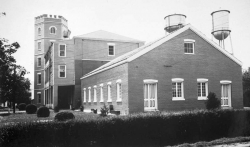Mt. Vernon Insane Hospital
| Mt. Vernon Insane Hospital | |
|---|---|
 | |
| Construction Began | 1890 |
| Opened | 1902 |
| Closed | 2012 |
| Current Status | Closed |
| Building Style | Cottage Plan |
| Location | Mt. Vernon, AL |
| Alternate Names |
|
History
Constructed by the US Army in 1828 for making munitions originally. In the late 1880s the arsenal was used to confine captured Native Americans including Geronimo. The land was deeded to the state of Alabama in 1895 and the hospital was built in 1902 to relieve overcrowding at Bryce State Hospital.
Mount Vernon Hospital for the colored insane, now known as Searcy Hospital, was opened in May 1902. Prior to the opening of the Mount Vernon facility, African American patients were maintained in segregated quarters at Bryce State Hospital in Tuscaloosa, which opened in1860. The 1863 annual report reflects an all white patient population. However, by 1868 annual reports indicates a payment of $1900 by the Freedman’s Bureau to care for the twenty-six African American patients at the facility. By the end of 1902, four hundred African American patients were at the Mount Vernon facility.
It served African-Americans exclusively until 1969, when it was desegregated after the Civil Rights Act of 1964 was enacted. On May 26, 1988, the Mount Vernon Arsenal/Searcy Hospital Complex was added to the National Register of Historic Places as a Historic District. The current site is made up of 25 buildings over 360 acres. The modern-day Searcy Hospital currently has 408 extended-care beds and a 124-bed intermediate care unit for patients with severe mental illness. It also serves the female forensic in-patient psychiatric center for the southern 1/3 of Alabama. From wiki and state archives
Images
Cemetery
A map of the site suggests there could be at least 740 graves, laid out in tight formations that form a peculiar shape. Headstones made of either concrete, wood or metal are assigned to places on the ground, marking the spot where the hospital once buried its dead. Death records and interviews with former hospital workers suggest a burial hasn't taken place at Searcy since the 1940s.





